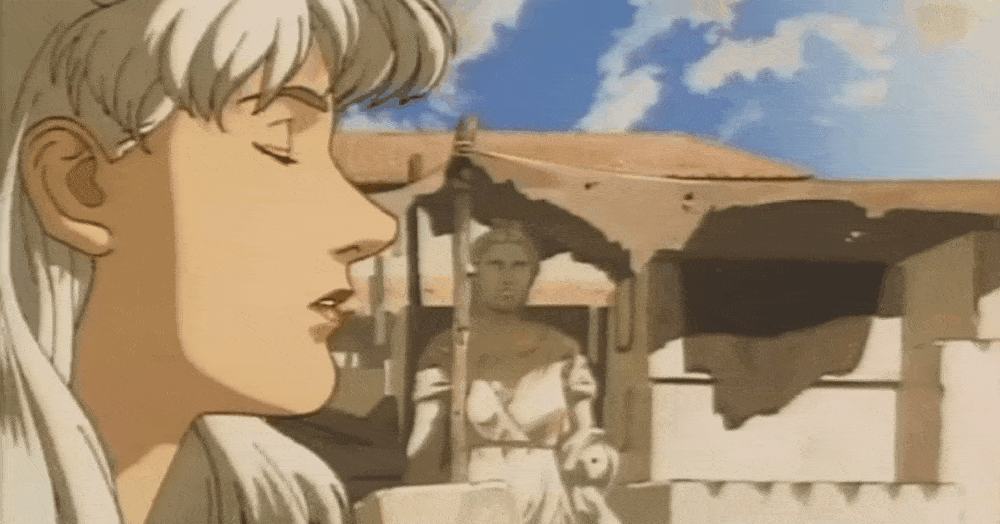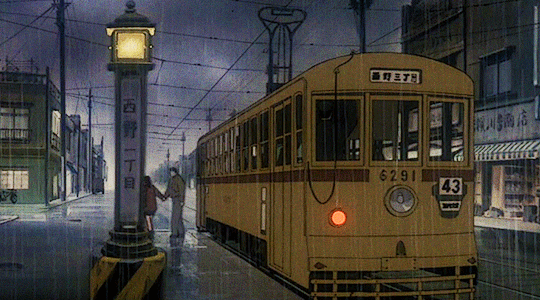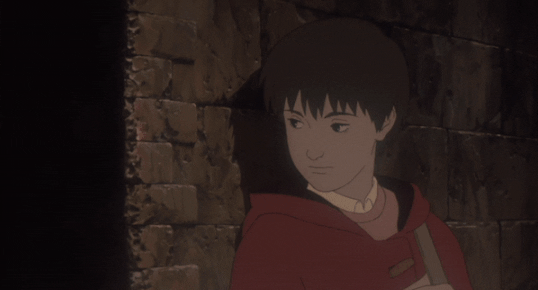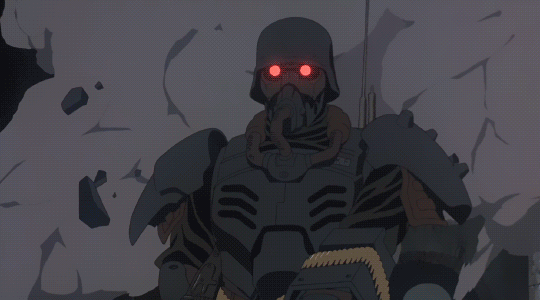originally posted at https://canmom.tumblr.com/post/705645...
Hi friends, running late so please accept a brief writeup today - on a subject that deserves a lot more, but probably best done after the film. I’m also planning a followup film night for the rest of the ‘Kerberos Saga’.

So remember those 'realists’ of the 1990s? I speak about them now and again here, leaning hard on the writing of Matteo Watzky and, now and again, Animation Obsessive. It’s the latter who gave me the material for this night, in their article The Anime Realism of Run, Melos!.
'Realism’ is a subject that demands endless examination. For there to be a 'realism’, you need something that is not real, and then to bring it 'closer to’ realism in some respect. I’ve talked in the past about Matteo Watzky’s The Purpose of Realism in Animation, where he looks at the three realisms of Takahata, Kon and Yamada, which each go to different purposes. To these we could add many more takes on the idea in animation: the Disney 'realism’ derided by the Zagreb School, the HDR hyperrealism of Shinkai.

And we can tie that to a discussion of 'realism’ in literature. Psychological realism, sci-fi/fantasy verisimilitude, magical realism… or in art, socialist realism and all that. It’s a term that is polyvalent as fuck.
My mum recently asked me what sort of animation I’d want to create, and oddly enough it turned out the examples that sprang to mind often weren’t the realists. Alongside clips from Tokyo Godfathers and Ghost in the Shell, and James Baxter’s scenes in The Prince of Egypt, I pulled up much more stylised bits like the transformation sequence from PMMM: Rebellion, the chase from Tekkonkinkreet, a fight scene from Fog Hill of Five Elements… I didn’t show her Aeon Flux because lmao but it would have been fitting too. There’s many dimensions beyond realism, e.g. the choreographed and theatrical.
So why realism then?
The easy and not very helpful answer is that 'realism’ in its many forms is a device that can be used (well or badly) to different purposes. 'Realism’ in animation is especially challenging, and thus by default prestigious, or perceived as such - a sentiment that’s evident in the recent 'chainsaw man vs bocchi’ discourses lol. Yet there’s a certain intrinsic, intuitive appeal in realist animation - it’s one of the first things people move to praise.
The longer answer, to try to go beyond what Watzky wrote… I’m still thinking about.
All that said, let’s go visit Hiroyuki Okiura! Alongside Toshiyuki Inoue, he’s among the best known realist animators, with a list of amazing credits including the spotlight chase scene in Akira, the spider tank scene in Ghost in the Shell as well as (nsfw) some astonishingly 3D-like animation in the opening sequence, the 'everyday life on Mars’ opening credits of Cowboy Bebop: The Movie, the running scenes at the climax of Your Name, the lotus eater scene in Magnetic Rose, a groundbreaking fight scene in The Hakkenden… I could easily keep going. It’s a very traditional sense of realism, reliant on extraordinary solid drawing and carefully observed movement more than fancy compositing effects.

He’s worked as a director as such twice, but he’s also worked as animation director in a few other cases. One of these is Run, Melos! (1992), a relatively obscure work which I’d never have heard about if not for AniObsessive’s article. As such, I’ll let them introduce it:
Run, Melos! adapts a short story by Osamu Dazai, a Japanese author from the 20th century. By the time this film premiered, Dazai’s original was already a near-universal reference point in Japan — the kind of thing that everyone had read in school.
The gist: a rural peasant named Melos is sentenced to death by the ruler of Syracuse. Melos begs to be allowed to attend his younger sister’s wedding back home before his execution. As collateral, his friend Selinuntius (shortened to Seline in the film) gets put in his place. If Melos doesn’t return in time to be executed, Seline will die.
It’s a classic. But Masaaki Ōsumi, who wrote the screenplay as well as directed it, took liberties with the original short story. He wondered, “Why did Seline become a hostage so easily?” In Dazai’s version, it’s unexplained. Ōsumi wanted more realism.
And thus he brought in Okiura, who had just previously worked as animation director on Record of Lodoss War (1990) and animated on Roujin Z (Animation Night 118). They took scouting trips to the Mediterranean and made a point of trying to draw their characters looking Greek rather than Japanese. A young Satoshi Kon followed Okiura, and anecdote has it that he would drink until the early morning, ranting about the anime and manga business. Mitsuo Iso, not yet the star he would become after Eva, animated a very carefully grounded horseback fight scene. The result is sometimes animation by figures like Inoue that feels 'more real than live action film’.
We can compare the 'realism’ demanded of the animation with the story. Although Ōsumi hoped to expand on and flesh out the characters and motivations, it’s adapting quite a brief parable, and this tends to be the sticking point. I want to see what purpose the realism serves though, and regardless, I’m sure we’re going to see something beautiful.

At the end of the decade, Okiura got the chance to direct his own film, courtesy of Mamoru Oshii. As well you know, Oshii is well known for his near-future scifi animated films like Ghost in the Shell and the Patlabor series, and of course he’s come up on canmom.gov before, e.g. Animation Night 38 (which currently mistakenly credits Jinroh to Oshii) and 39 and 115, and Toku Tuesday 39. Back then I talked briefly about his 'Kerberos Saga’, which is as best I can understand, about an alternate future Japan ruled by the Nazis. The first two films in the franchise are The Red Spectacles ('87) and StrayDogs: Kerberos Panzer Cop ('91), both tokusatsu; there’s also about a million spinoffs.
Anyway, despite all appearances at first glance, Jin-Roh was directed not by Oshii but Okiura. Oshii had hoped to do a sequel for a while, and the success of GitS made it possible, but conflicts with scheduling his other works forced him to give up directing the film to someone else.
That someone else ended up being 'allergic to computers’ Okiura, judged the most promising of the studio’s younger generation and eager to direct a serious drama film. Okiura made many decisions that Oshii wouldn’t; his take on the story put a bit more emphasis on the romantic relationship, and he ambitiously decided to do a film with no CGI whatsoever at a sprawling 80,000 cels.
By all accounts, he succeeded. His film is heavily in an Oshii idiom: very slow and contemplative, morally ambiguous, set in the near future, about cops. Its story tells of a member of a counter-terrorism unit in the context of widespread protests, who decides not to gun a girl who turns out to be a suicide bomber, and later encounters someone who claims to be her sister. There’s infighting among the security arms of the fascist regime and its main character Fuse performs increasingly inhuman acts for the sake of preserving his unit, all framed through a metaphor of Little Red Riding Hood.
It became a well-regarded classic (at least among the small segment of people who have heard of it), and now if you introduce Okiura it’s usually as 'director of Jin-roh’.
I’ve long aspired to watch Jin-Roh in the context of the other two Kerberos films, to finally come up with my own answer on the whole 'what is it doing with all that fashy imagery’ question. There certainly isn’t time for that tonight, but I think it might be possible over the weekend. So for this reason, we’ll save further discussion of Jin-Roh for now…

Okiura returned to key animation - I’m not sure why! maybe he just liked it more - and it would be another 12 years until he’d direct another film. That film is A Letter to Momo (2011), about a grieving girl who encounters three yōkai who have been transformed by divine punishment, who are tasked with protecting her as she comes to accept the death of her dad.
Although the premise is fantastical, visually it has a lot of the feeling of one of Takahata’s very grounded films like Only Yesterday, with astonishingly naturalistic movements drawn by the hands you might expect - Okiura himself, Inoue, Shinya Ohira, Takeshi Honda and Masashi Ando. In a way it’s kind of the realists reuniting to make a 90-style film once again, but there’s also shades of the experiments we’d see the next year in the Animator Expo. It sounds like it’s gonna punch me right in the heart in terms of 'anime about grief’, but maybe it’s going to be exactly the film I need to see.
So here’s the plan for this week’s Animation Night entertainment: tonight we’ll visit Run, Melos and A Letter to Momo. On Tuesday I’ll follow that up with a one-off special Toko Tuesday in which we’ll watch the two live-action Kerberos films and Jin-Roh. And at some point I’ll try and write something a lot more substantial than this brief intro.
after watching...
letter to momo was a really good film. yeah, close to home, I cried a lot, but just on a pure filmmaking level too, this is astonishingly tight, with some of the best naturalistic character animation I’ve ever seen.
some aspects, like the decision to rotate cars and boats in traditional animation rather than doing the obvious and using 3DCG, seem like a pure flex. (the film isn’t entirely without CG, there’s a few noticeable shots in the finale, but way less than you’d expect given both the era and Production I.G.’s established proficiency integrating 2D and 3D). the backgrounds? gorgeously lush paintings in muted colours. the yōkai? the main trio are wonderful, each strongly characterised and charming, but there’s also the background yōkai who turn out to be animated by none other than Ayumi Shiraishi of Gekidan Inu Curry.
as a story, while the broad strokes are as you might imagine - a personal conflict (Momo’s grief and regret on the terms she parted from her dad, her fear that the same conflict could happen with her mum, her mum masking her emotions) meets a supernatural one (three goofy guardians assigned to protect Momo until her dad can reach the ‘sky’; they steal from people, Momo has to hide them), shifting gears between playful and sad, then a conflict that brings the two together and forces the yōkai to stand up from being goofy little guys and do the right thing - it’s executed with so much grace and care that there’s nothing to really argue with.
this is where Okiura’s famed realism really works for it, helping to ground the expressions of emotion and often communicate what’s going on without dialogue. I don’t think you could find many better films to see animated acting. not even Junkers Come Here. Inoue had some amazing shots in Miss Hokusai, but here everything is imbued with subtle character: running down a street or standing up as much as the big stuff. they even manage to match Miyazaki on wild boars.
I’m genuinely surprised it’s not more widely known. steering too close to Miyazaki idioms (structurally it’s not unlike Ponyo) without the name attached? too far from what Production I.G. is known for? I can’t say! Miss Hokusai was the same. quietly excellent animated dramas that barely seem to be acknowledged. I hope it did well in Japan at least.
as it turns out, there’s a third one like that. Giovanni’s Island will definitely be coming to a future Animation Night. until then, thank you for watching, see you on Tuesday for Okiura’s other one~
Comments